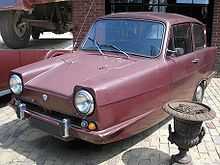Reliant Regal

The Reliant Regal was a small three-wheeled car manufactured from 1953 until 1973 by the Reliant Motor Company in Tamworth, England, replacing the earlier Reliant Regent cyclecar van. It was a three-wheeled vehicle, therefore under UK licensing it was considered a tricycle. Due to the lightweight construction, under seven cwt, the vehicle could be driven on a motorcycle licence in the United Kingdom. A light-commercial version with a side-hinged rear door was marketed as the Reliant Supervan.[1]
History
Following the launch of the Mk I in 1953, the Regal passed through many revisions in a short period, with the "first generation" using the original wooden frame and discrete-panel bodywork design through to the 1961 Mk VI.[2]
In 1962, Reliant introduced the Mk VII,[3] code named "TW7" (Three Wheeler 7). This version featured a new OHV Reliant engine, a new steel chassis and bonded shell design for the body, fully updated visual styling, and was badged as the Regal 3/25, Regal 3/30 (number of wheels/bhp), Regal 21E or Regal 21E 700. The 600cc engine produced 25 bhp (actually 598cc/24 bhp) and the 700cc engine produced 30 bhp (actually 701cc / 29 bhp). The 21E version was fitted with 21 extras, which were otherwise available as optional extras to the standard car. These extras included a spot light, a fog light, chrome plated bumper over-riders, sun visors, an oil gauge, outer wheel trims and metallic paint. In 1973, the Regal was replaced by the Reliant Robin (code named "TW8").
Regals MkI-MkVI had aluminium bodies and 747cc side-valve engines. However, during the 1950s, the price of aluminium increased markedly across Europe. In response, Reliant developed an expertise in making panels of glass fibre which piece by piece replaced the aluminium panels, until the 1956 Mark 3 Regal featured a wholly glass fibre body.[4] Unlike Panhard, who responded to the increased cost of aluminium by substituting heavier steel panels, Reliant's choice of the glass fibre technology ensured that the Regal was able to retain its advantageous light weight, with the resulting ability to use smaller, lower powered and therefore cheaper and more economical engines. The Regal Mk VI was the last Regal to be powered by a side-valve engine, as by 1962 Reliant had developed their own all aluminium 600 cc OHV engine that was fitted into the new Regal 3/25.


A few months later, in August 1968, the 701 cc engine introduced in the Reliant Rebel the previous Autumn found its way into the Regal.[6] For the three-wheeler, the compression ratio was lowered to 7.5:1, reducing the power to a claimed 29.5 bhp from the Rebel's 35 bhp.[6] Nevertheless, this still represented a useful increase over the 26 bhp claimed for the 600 cc unit which the 701 replaced.[6]
Exposure in popular culture

Reliant Regals and Robins enjoy something of a special place in British culture as symbols of British eccentricity. An example of a Reliant is the iconic van belonging to Del Boy and Rodney Trotter in the long-running BBC sitcom Only Fools and Horses. The van is frequently, and incorrectly, referred to as a Robin, but is actually a Regal Supervan. The Trotters' original van is now on display in the National Motor Museum, Beaulieu, while one of two 'back-up' vans was sold in 2007 for over £44,000[7] to British boxer Ricky Hatton. Copies of this iconic van appear for sale on auction websites.
In another TV comedy, Mr. Bean, a running gag in the series is the titular character played by British Comedian Rowan Atkinson frequently comes into conflict with a light blue Reliant Regal Supervan III, which gets tipped over, crashed into, or bumped out of its parking space.
A red Supervan appeared in the S4C Welsh language children's programme "Fan Goch".[8]
The 2011 Disney film Cars 2 features a French character named Tomber who is patterned on a Reliant Regal saloon car, with some creative modifications, such as the headlights of a DS. His name means "to fall" in French, referencing the reputed instability of three-wheel vehicles.[9]
A Reliant Regal is shown in the closing ceremony of the 2012 London Olympics with it falling apart and Batman and Robin coming out of it, a plot that appeared in an episode of the long-running BBC sitcom Only Fools and Horses.[citation needed]
References
- ↑ "The Reliant 5cwt Supervan III". Oldclassiccar.co.uk. Retrieved 27 June 2010.
- ↑ "Reliant Regal Mk I - Mk VI". 3wheelers.net.
- ↑ "Reliant Regal Mk VII". 3wheelers.net. Retrieved 12 July 2012.
- ↑ "Robin's rest". CAR: pages 106–108. December 2000.
- ↑ "News and Views: A Reliant Milestone". Autocar. 128 (nbr3768): 29. 2 May 1968.
- ↑ 6.0 6.1 6.2 "News and Views: Larger engines for Reliant Three-Wheelers". Autocar. 129 nbr 3785: 54. 29 August 1968.
- ↑ "UK | England | London | Del Boy's Reliant makes a killing". BBC News. 27 February 2007. Retrieved 27 June 2010.
- ↑ "Cer i Greu". S4c.co.uk. Retrieved 27 June 2010.
- ↑ "Tomber". disney.go.com. Retrieved 2 June 2011.
External links
| Wikimedia Commons has media related to Reliant Regal. |
- Photographs and data on various Reliant Regal versions
- Reliant Regal Supervan III restoration project